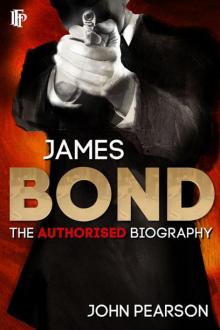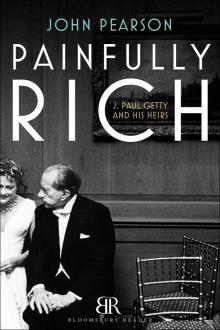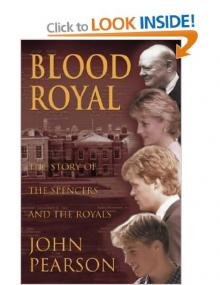- Home
- John Pearson
Blood Royal: The Story of the Spencers and the Royals
Blood Royal: The Story of the Spencers and the Royals Read online
Blood Royal
The Story of the Spencers and the Royals
John Pearson
Contents
Introduction
1 The Rise and Rise of the Spencers
2 Shameless Sunderland
3 The Great Inheritance
4 A Liberated Woman
5 The Divide
6 The First Earl
7 ‘A Wild and Scrambling Life’
8 The Great Library
9 Reform and After
10 The Holy Tramp
11 The Red Earl
12 ‘Dearest Boy’
13 ‘Jolly Jack’
14 The Fermoys
15 Raine’s War
16 A Royal Fairy Story
17 Death of a Princess
Epilogue
Sources
Notes
Introduction
On the July morning in 1981 when Diana Spencer married Charles Windsor, Prince of Wales, the bride’s father left his flat in Grosvenor Square before being driven off to Clarence House, from where he would accompany the twenty-year-old virgin bride in the Royal Glass Coach to St Paul’s Cathedral.
A tall, rather shaky figure in his pale grey morning coat, Edward John, eighth Earl Spencer, had never entirely recovered from the cerebral haemorrhage he had suffered three years earlier, and there were fears as to how he would cope walking his daughter up the aisle before the assembled royal family, the massed cathedral congregation and nearly a billion television viewers round the world. (In fact he did it rather well.)
Just before leaving home, he managed to read out to the journalists waiting by his doorstep a carefully prepared statement of three short sentences specially composed for the occasion with the help of his second wife, Raine, Countess Spencer, daughter of the romantic historical novelist Barbara Cartland.
‘The Spencers have through the centuries fought for their king and country. Today Diana is vowing to help her country for the rest of her life. She will be following the tradition of her ancestors, and will have at her side the man she loves.’
History was clearly on Johnnie Spencer’s mind around this time, for not long before, also in front of journalists, he had mused aloud, as was his wont, about the forthcoming royal marriage.
‘Honestly, what do I get out of it? You’ll say the glory, but is glory the word? My family go back to the Saxons, so that sort of thing’s not a bit new to me.’
Even allowing for the fact that history had never been the eighth Earl’s strongest suit, remarks like these appear distinctly odd, revealing as they do an extraordinary depth of ignorance about his own family. For except in the sense that all our families go back somewhere, the Spencers simply don’t ‘go back’ to the Saxons, and if there were any Saxon Spencers, no one knows if they kept pigs, tilled the fields or were hanged for cattle-stealing.
Nor do the great majority of Spencers whose lives we do know about in detail seem to have been over eager to ‘fight for king and country through the centuries’. Of the nineteen individuals who have headed the Spencer family from the days of its founder, Sir John Spencer, back in the reign of King Henry VIII, only four saw any service for what might be broadly termed their ‘King and Country’. The only one actually slain on the battlefield was a reluctant cavalier who thoroughly disliked his king and entertained grave doubts about the royal cause he died for. Of the other three, one, the future fourth Earl, fought bravely in the Royal Navy in alliance with the French and Russians in a naval battle with the Turks and the Egyptians; the second, Johnnie’s father, ‘Jolly Jack’, seventh Earl Spencer, received a German bullet in the knee in Flanders and Johnnie himself saw active service with the Royal Scots Greys in the last two years of World War Two.
The rest of the Spencers range from more than half who could be described as calmly indifferent to the fortunes of their King if not their Country, to one avowed republican and several who, as dedicated Whigs, had little time for royalty in any form, except when they were milking the royal exchequer or doing their best to crop the powers of the king still further. One Spencer courtier seriously advised King George III to have the Prince of Wales murdered.
It was only on the subject of his daughter, Diana, that Johnnie Spencer spoke truer than he knew, when promising that she would ‘follow the traditions of her ancestors’. Indeed, back in 1980, when the idea of her marriage to Prince Charles was first mooted, had the royal family and their advisers known just how closely she would end up doing this, they might have paused before welcoming her so warmly to their bosom. But again, at the time of the royal wedding, no one was very interested in the history of the Spencers, or particularly aware of the extraordinary tribe that Diana sprang from.
Certainly no one even half aware of her ancestry would have regarded ‘shy Di’, the demure ex-nursery-school teacher, as a malleable and harmless Cinderella figure who would bring painless glamour and romance to a lacklustre Royal Family, however badly she was treated. Indeed, they would probably have guessed that a direct descendant of Sarah Marlborough, who was also a distant kinswoman of Sir Winston Churchill, was unlikely to put up with being pushed around for ever - and that she would more than likely shake the throne if slighted. It was also conceivable that this girl from a family which boasted a nineteenth-century monk who died in the service of the poor and is currently a candidate for sainthood, might herself attempt to help the sick and needy. Nor should anyone have been entirely surprised when this distant niece of Georgiana Spencer, later Duchess of Devonshire, and undisputed queen of late eighteenth-century fashionable London society, suddenly turned herself, with such instinctive magic, into one of the most glamorous women in the world.
The most striking thing about the history of the Spencers is the range and richness of the individual characters involved, along with the diversity of their achievements. They really are a most unusual family, and it is this that makes their rise and continuity across so many generations such a fascinating story, culminating as it does in the tragic story of Diana Spencer.
Towards the end of her life Diana told a friend that she was prouder to have been a Spencer than a member of the House of Windsor, and her Spencer heredity must, in part at least, explain the mystery of how she found the strength to cope with a situation few others could have handled. Similarly her heredity must have also played its part in that startling transformation from the most naive and unsophisticated of child-brides into the most famous woman in the world.
Ironically, it is only following her death that one realises just how much she really was a Spencer. And now that her most important legacy rests in the two young princes that she leaves behind, the history of the family appears more relevant than ever. For while one cannot be too dogmatic about the often contradictory workings of heredity, already those dominant Spencer genes have brought a startling change to the future appearance of the British monarchy. Both boys are very much Spencers, and William in particular bears a startling resemblance to his mother, having the same classic profile and even the same wary glance which Diana so often gave the world. At sixteen, six foot two and still growing, Prince William promises to be the first very tall English king since Charles II. Following more than a century of distinctly short British monarchs, this in turn suggests that with the Royal Family the Spencer genes have overridden those of tiny Queen Victoria, and that something new and unexpected will succeed them.
At the moment it is still impossible to predict the result of this Spencer presence upon the future character of the monarchy, but one could make some interesting guesses after learning more about the rich and revealing history of the House of
Spencer.
Chapter 1
The Rise and Rise of the Spencers
For several years before he died in 1522 Sir John Spencer had been pondering his tomb for the church of St Mary in the Northamptonshire village of Great Brington. It had to be as dignified and grand as possible, with life-sized alabaster effigies of himself and his wife, Isabella, lying dutifully beside him. He would be wearing armour, with a dagger at his hip, and Isabella was to wear her favourite cloak, with the three gold chains that he had given her around her neck, and two of her favourite puppies at her feet.
No one knows how much he paid the sculptor, but Sir John could clearly afford it. For, having planned his tomb, his thoughts did not rest there. He was not concerned solely with his own memorial, but was already making preparations for the future glory of his family. What better way than to build a sanctuary where he and his as yet unborn descendants could lie together and proclaim in death the splendour of the living?
Sir John must have discussed all this with Thomas Heritage, the rector of Great Brington, for Thomas was a clever man who would later move to London and become Surveyor of the King’s Works, a post involving him in the building of a far grander sepulchre – the great renaissance tomb, by the Florentine sculptor Torrigiano, for the king’s father, Henry VII, in his magnificent chapel in Westminster Abbey.
But the Spencer chapel in Great Brington Church has a touch of magnificence all its own. Here, in this unassuming country church, Sir John’s chapel, with its pillars and elaborate stone tracery, forms what the omniscient Professor Nikolaus Pevsner – not one for unnecessary praise – described as one of the county’s ‘great storehouses of costly and self-confident monuments’.
Note the word ‘self-confident’. For when he built his chapel it was as if Sir John foresaw the future splendours of his line, and was willing his descendants to be worthy of this splendid resting place he was creating for them all.
This was remarkable enough, but what makes the Spencer chapel extraordinary is that the tomb he built for himself is not exactly what it seems. The heraldic shields, the knightly posture, and the other trappings of chivalry proclaim the presence of a great medieval noble.
But Sir John was nothing of the kind. He was a prosperous farmer who had moved to Northamptonshire from the nearby Warwickshire village of Wormleighton some years earlier. And the money for his tomb and chapel did not come from knightly deeds in foreign parts or courage in battle or the service of a royal master. It came from sheep.
If the ‘green and pleasant land’ of Diana, Princess of Wales’s favourite hymn exists, it has to be in the gentle fields and fertile valleys of Northamptonshire. Together with its next-door neighbour, Warwickshire, this whole area of the Southern Midlands forms the rich green heart of England, large areas of which were once a royal forest.
Northamptonshire remains a secret county. Tucked beneath the industrial Midlands, which barely touch it, it has stayed far enough away from London to avoid the suburban fate of the Home Counties, while keeping contact with the capital. Northampton itself is not a graceful city. In the last century it found fame as ‘the footwear capital of England’: but the countryside is never far away, and large areas of this county of ‘spires and squires’ remain unspoiled. With fine hunting country, it has attracted the fox-hunting gentry and nobility, and supposedly boasts more of their ‘magnificent and elegant seats’ than any comparable county in Britain. Here they have tended to stay put across the centuries and still survive as nowhere else in England.
The sheep have also stayed put in the fields around Great Brington, black faced, mysterious creatures with their stiff disdainful gait and their alchemist’s ability to turn green fields into meat and wool and money - in the days of the Tudor Spencers, very large amounts of money.
When Henry VIII was crowned, the demand for English wool was starting to produce a boom in sheep production not unlike the twentieth century’s boom in the demand for oil. Sheep-farming was already big business and the great ‘sheep walks’ of the Cotswolds, Derbyshire and Romney Marsh dedicated solely to enormous flocks of sheep, amazed the foreign visitors to Tudor England.
What was good for sheep was not so good for human beings, and the creation of sheep walks caused widespread suffering. But what became a social problem for Tudor governments was a golden opportunity for great ‘sheep masters’ like Sir John Spencer, who realised that turning large tracts of fertile land to sheep was the surest way to make a fortune.
Spencers had been farming in Warwickshire for generations, but it was only with Sir John’s arrival on the scene that their lives began to change appreciably. It was he who brought the family to Northamptonshire by purchasing the loam-rich pasturage round Althorp, and in 1508 he followed this by building there a timber and redbrick manor house, probably on the site of an earlier medieval structure, set in a hollow to protect it from the elements. He had only recently enlarged the family home at Wormleighton, but he needed Althorp as a centre of operations for the seven hundred acre sheep-run he had bought and in 1512 he was licensed to create a deer park round his house - proof of his new gentlemanly status.
As founder of the family, Sir John was clearly a remarkable man - not least because of the way that in his youth he seems to have avoided the temptation of taking a swifter but far riskier path to riches in the service of the crown. His maternal uncle was the notorious Richard Empson, who together with his partner Edmund Dudley, became Henry VII’s richest and most extortionate tax gatherer. Following the practice of the day, the young John Spencer could almost certainly have made a career working for this powerful relation. But Empson’s extortions made him widely hated, and when Henry VIII executed him as a scapegoat in 1510, it must have been a fearsome lesson to his nephew and to his descendants on the hazards of the court and royal service. Unlike many rising Tudor families, the Spencers would carefully avoid the court as a source of enrichment for many years to come, and although John Spencer proved extremely sharp at making money, he also showed unusual concern for the future of his family in the care he took never to create unnecessary enemies.
Allowing for the flattery of a later generation, his description by an eighteenth-century genealogist as a ‘noble spirit tempered with the greatest humanity’, may well have had some basis in reality. Certainly Sir John took his social and religious obligations very seriously, being ‘liberal to his poor neighbours’, and rebuilding several local churches, including Great Brington and Wormleighton. Since the land round Althorp had already been cleared for sheep, so the peaceable Sir John was able to avoid arousing anyone’s enmity through evictions. His anxiety to avoid feuds against the family even extended to his will, where he charged his executors after his death to ‘recompense anyone who could prove that he had done him damage’.
During the last years of his life, John Spencer advanced unspectacu-larly but surely, becoming sheriff for Northampton in 1511, and being knighted by King Henry VIII soon after. This also established his family as being of knightly rank, and all his successors would receive the same honour. At the same time, although Wormleighton remained his principal residence, something must have told him that Althorp was the place where the future of the Spencers really lay.
Like the shrewd countryman he was, at Althorp he had selected some of the finest pasturage in England, and since it was purchased out of capital, he left no debts behind to plague his children. He also knew what he was doing when he chose this land so close to the territory the Spencers already farmed in Warwickshire, which meant that their two great sheep walks could be run with maximum efficiency and the whole be ‘treated as a vast single flock’.
There is something very up-to-date about his insistence on cutting labour costs and rationalising activities into this single large-scale holding. Before he came to Althorp he had run the entire Wormleighton sheep walk with nine skilled shepherds managing upwards of 10,000 sheep, which meant that he could check his employees’ honesty and personally supervise the way they did
their work. Now he could do the same at Althorp.
As a good businessman he was also unusually responsive to the demands of the market. According to Trevelyan the one defect of English sheep was that, being bred exclusively for wool, they tended to be ‘pitifully small and thin’. Knowing the Englishman’s love of meat, Sir John bred his sheep not only for their wool but for their flesh, and was soon selling them to the area around Northampton and ‘when it was fatt to the Citie of London and other places yerely’.
But in spite of his self-confidence, the fact remains that however rich he was, Sir John was gambling on the longest odds when he built his chapel for the future glory of the Spencers. As he must have known, it was rare for farming families to stay prosperous over several generations, and local gentry like the Spencers were particularly vulnerable.
According to J.H. Plumb, ‘Throughout the centuries … landed families had risen only to fall again. For one that survived a score were destroyed, overtaken by those natural disasters which beset families - failure of heirs, wanton extravagance, reckless loyalty, sheer bad luck. But debt, the crushing, inexorable burden of debt, extinguished most.’
Even for Sir John, the thought of debt must have been a constant nightmare for the future, worse than the smallpox or the wasting flux or death in childbirth. There was one sure shield against it -money; and he taught his children by his own example to acquire it and invest it, and never, never waste it.
Apart from the profits from his sheep, there was another method of enrichment which Sir John bequeathed to his descendants. As a sheep-breeder he had learned that money spent on stock to improve the strain was rarely wasted. The same applied to sons and daughters, and Sir John was the first of the Spencers who seriously concerned himself with hyperogamy - the art of marrying above one’s station.
A good marriage, particularly for a son and heir, was a wonderful investment, since it produced not only useful family connections but also whatever dowry or inheritance the bride brought with her. As with everything in money-conscious Tudor England, it could be expensive to provide a son with an adequate settlement to win an heiress. But just as the Spencers put their money into breeding better sheep, so Sir John began the practice of investing in fine marriages to enrich the family.

 The Bellamy Saga
The Bellamy Saga Notorious: The Immortal Legend of the Kray Twins
Notorious: The Immortal Legend of the Kray Twins Learn Me Good
Learn Me Good James Bond: The Authorised Biography
James Bond: The Authorised Biography Painfully Rich
Painfully Rich The Profession of Violence
The Profession of Violence Biggles
Biggles Blood Royal: The Story of the Spencers and the Royals
Blood Royal: The Story of the Spencers and the Royals